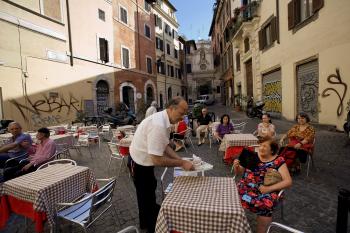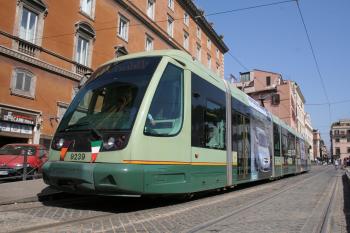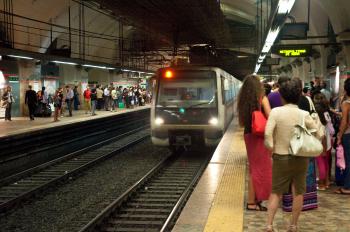Getting Around Rome
Getting Around Rome
All City Transport Options: What Locals Use and What’s Best for Tourists
General Overview
Getting around Rome can be an adventure in itself, and you'll quickly learn it has its own unique rhythm. First off, the public transport system here is a blend of the local buses, trams, and the metro. Sure, it’s efficient, but you’ll see it's not always on time (a classic Roman trait). The metro lines operate from around 5:30 AM to 11:30 PM on weekdays, with extended hours on weekends—perfect if you fancy a late night out.One of the biggest mistakes many visitors make is relying solely on the metro to explore the city. While the Line A (the orange line) is great for getting to spots like the Vatican, it's not the only way to see the sights. Rome's charm really lies in its winding streets, best appreciated from a bus or tram. Plus, you’ll want to hop on the 62 bus at Termini to reach the Colosseum—it’s a local favorite!
Oh, before I forget, keep in mind that a single ticket costs €1.50 (which you can use for 100 minutes across the metro, buses, and trams). If you think you'll be riding the metro and buses a lot, a weekly pass at around €24 could save you some dough versus buying separate tickets. Trust me, taxis can burn a hole in your pocket, especially during peak times when surge pricing kicks in.
My first experience with the metro was chaotic—I found myself crammed like a sardine during rush hour in the hot summer. Short story: I almost missed my stop because I couldn't even move! But after a few journeys, I discovered the metro is quite clean and easily navigated if you avoid peak hours. Speaking of weather, Rome can get sweltering in July and August, so if you're planning to take the metro during those months, aim for early mornings or late evenings to dodge the heat.
One local tip is getting off a few stops early and walking to your destination. The routes through neighborhoods often reveal hidden gems like cozy cafes and artisanal shops that you’d miss if you just zoom through on the metro. And a final reminder: always keep your belongings close—pickpocketing can happen, especially on crowded buses.
In summary, when you're traversing Rome, don't just stick to the metro. Explore buses like the 64 for a scenic route, and remember that sometimes walking gives you the best experience. Enjoy getting lost in the beautiful chaos!
Types of Transport

popular with tourists
Walking in Rome is one of the best ways to truly immerse yourself in the city’s rich history and vibrant culture, as many of the most famous sights—such as the Colosseum, Trevi Fountain, and the Roman Forum—are within walking distance of each other. There are no costs for walking, of course, but ensure you're wearing comfortable shoes, as cobblestone streets can be tough on the feet during long excursions. A great tip is to take a leisurely stroll through the Trastevere neighborhood, famous for its narrow lanes and charming piazzas, especially during the late afternoon when the evening lights start to come up; this area is not only picturesque but also offers several great dining options. When exploring, always keep an eye on your belongings, particularly in crowded tourist areas, and stick to well-lit streets if you're out after dark. Lastly, downloading a walking map or a history app can enhance your experience by providing valuable context as you pass by ancient landmarks.

popular with tourists
The tram system in Rome is a convenient way to explore the city, covering several key areas including Trastevere, Testaccio, and the central Termini area. A single ticket costs €1.50 and is valid for 100 minutes, allowing transfers between trams, but you must validate your ticket before boarding at the machines located at the tram stops. For tourists, Tram 8 is particularly noteworthy as it provides direct access from the historic center to vibrant neighborhoods like Trastevere, where you can enjoy local dining and nightlife.
To save time, check the tram schedules online or through public transportation apps to avoid long waits, as the trams run approximately every 10-20 minutes depending on the route. Lastly, while trams are generally safe, be mindful of pickpockets, especially when they are crowded.
To save time, check the tram schedules online or through public transportation apps to avoid long waits, as the trams run approximately every 10-20 minutes depending on the route. Lastly, while trams are generally safe, be mindful of pickpockets, especially when they are crowded.

popular with tourists
Taxis in Rome are readily available and can be easily flagged down on the street or found at designated taxi stands, particularly near major tourist attractions, train stations, and airports. Typically, a short ride within the city center costs between €10 and €20, but be aware of extra charges for late-night fares, luggage, or traveling to/from the airports, which can add €5-€10 to your fare. It’s a good idea to confirm that the taxi is an official one; look for the "TAXI" sign on the roof and ensure the driver starts the meter at the beginning of your journey. For time-saving, consider getting a taxi when visiting far-off attractions like the Papal Basilica of St. Peter or Ostia Antica, as public transport may take longer. Always check your belongings before leaving the cab to ensure you haven't forgotten anything, as the driver is not obligated to return lost items.

popular with tourists
The bus system in Rome is extensive, covering major tourist areas such as the Colosseum, Vatican City, and Trastevere, making it a convenient option for getting around the city. A standard ticket costs €1.50 and is valid for 100 minutes of travel on any bus, so be sure to validate your ticket before boarding at the machines located at the bus stop. One key tip for tourists is to download the ATAC app for real-time bus schedules and routes, which can save you time waiting at the bus stop. Additionally, buses can get crowded, especially during peak hours, so it's advisable to avoid rush hour if possible, typically from 7:30 AM to 9:30 AM and 5:00 PM to 7:00 PM. Always keep an eye on your belongings, as pickpocketing can be a concern in heavily trafficked areas.

The metro in Rome consists of three main lines (A, B, and C) that connect key tourist areas including Vatican City, the Colosseum, and the Spanish Steps. A single ticket costs €1.50 and is valid for 100 minutes from the first validation, allowing you to transfer between lines or switch to buses within that time. To save time, consider using the metro early in the morning to avoid long queues at popular attractions and ensure you check the operating hours, which are usually from 5:30 AM to 11:30 PM on weekdays and until 1:30 AM on Fridays and Saturdays. Always stay alert for pickpockets, especially during busy times, and hold onto your belongings while navigating crowded trains.
Motos are a popular and efficient way to navigate the bustling streets of Rome, allowing you to bypass traffic and access narrow alleys that larger vehicles can't reach. Rentals typically cost between €40 to €70 per day, and you can pay using credit cards at rental shops or cash, though it’s advisable to have some cash on hand for smaller operators. A key tip for tourists is to familiarize yourself with Rome's ZTL (Zona Traffico Limitato) areas, as entering restricted zones without a permit can lead to fines; look for signs indicating these zones and plan your route accordingly. To save time, consider using popular tourist neighborhoods like Trastevere and the historic center where a moto can easily bring you closer to attractions like the Vatican or the Colosseum. Lastly, always wear a helmet, keep your personal belongings secure, and be cautious of traffic, especially in busy intersections where motorcyclists often weave through.
Here you can learn about all types of transport in Rome. What transport is available, how to reach tourist attractions and which mode of transport is optimal.

